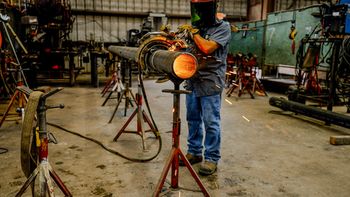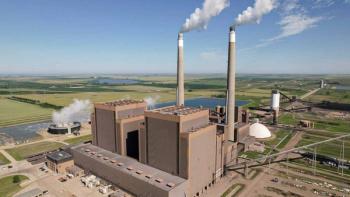
- Handbook 2025
- Volume 65
- Issue 6
Myth: Centrifugal Compressor Maps: Surge and Choke
Part two of this myth on centrifugal compressor maps delves into the map’s extrema: surge and choke.
Part one of our myth covered the fundamentals of centrifugal compressor head-flow maps. Although we’ve previously covered surge and choke in other Myth Busters columns, part two discusses it again since it’s such an integral part of compressor maps.
SURGE
All centrifugal compressors have a limit line that is nearly linear (at least for machines operating at modest Mach numbers) on the low-flow side of the map that corresponds to surge onset. Very often, this line crosses the peak head point of the speed lines, but there isn’t a good physical reason for this because surge is a system, not a compressor-related issue. Regardless, in most cases, surge occurs reasonably close but at lower flow than peak head on a speed line. For safety and engineering conservatism, most manufacturers and industry specifications put the map’s flow limit and, arbitrarily, the surge line at peak head, or to the right of this point if rotating stall is detected. Manufacturers also place a surge control line on the map parallel to the surge line, usually at a 10-15% flow margin to the right of it, which is used for controlling the surge control recycle valve with sufficient safety margins during fast system transients.
In reality, the surge (and surge control) line does not need to be linear—and in most modern control systems it is not—since it is defined by the onset of surge of different impellers in a compressor and is also impacted by viscous flow effects, fluid density (which is a function of pressure and temperature), and other fluid properties such as heat capacity and specific heat ratio. Furthermore, in some cases, the surge line can be far to the left of peak head, but this is, as previously noted, a system issue.
Finally, there is often significant confusion between compressor rotating stall and surge. Surge is a violent physical phenomenon that occurs in centrifugal compressor systems with the potential to cause significant damage to the compressor. Surge occurs when the compressor is not capable of overcoming the discharge pressure imposed by the system, specifically, when the compressor operates on the low flow side of its operating range where the capability of its impellers drops below the point of producing sufficient head to overcome the pressure difference between the high discharge pressure and low suction pressure. At that point, the gas will flow backward through the compressor from the pressure side to the suction side. As a result, the discharge pressure imposed by the system is reduced. Eventually, the discharge pressure drops low enough that the compressor can overcome it, and it will again flow from suction to discharge. If nothing in the system is changed, this process repeats, and various surge cycles occur until the compressor operating point changes.
On the other hand, rotating stall is an aerodynamic instability that sometimes occurs in a compressor component before the machine enters surge. Periodic compressor diffuser or impeller inducer flow separation leads to a localized and complete loss of through-flow in a single diffuser passage (or areas and moves from passage to passage). For vaneless diffusers, it is simply a rotating stall cell. This instability spins in the direction of the impeller’s rotation at a frequency below synchronous speed.
The major difference is that surge is a global phenomenon in which the entire compressor flow reverses, whereas rotating stall only affects small areas of the diffuser at any time. Rotating stall can potentially cause axial and radial vibrations that can damage the compressor, but operational restriction in this operating regime needs to be evaluated on a case-by-case basis, while full surge should always be avoided.
CHOKE
On the other side of the compressor map is choke. A centrifugal compressor’s maximum flow is mechanically limited by its allowable speed, the torque its shaft can handle, and the power provided by its driver (hopefully the latter before the former). Beyond that, the aerodynamic performance is limited by a maximum flow.
A compressor map is more than just test results. The map contains relevant physical and performance characteristic information that most turbomachinery engineers should understand to improve machine operations.
This limit is often referred to as choke, stonewall, or overload. Many manufacturers define a distinct overload limit; others provide performance maps where the speed lines end somewhere in mid-space. Of all the physical phenomena that affect a centrifugal compressor, choke creates the most disagreement among turbomachinery engineers, and it does not have a clear industry definition.
The classical definition of choke is when a fluid reaches its sonic point (Mach 1) in a flow constriction and volume flow cannot be further increased. Volume flow reaches a maximum and mass flow can only be increased through pressure; thus, density increases. This phenomenon rarely occurs in centrifugal compressors except when heavy gases with a low speed of sound are compressed. Specifically, this type of choke does not occur within many compressors, especially when lighter gases are compressed or the pressure ratios are low. Rather than going rapidly vertical, the head gently slopes downward as flow increases. In these cases, the flow never actually chokes, instead increased aerodynamic losses are responsible for the gradual head reduction. If actual choke occurs, it is one stage of the compressor that chokes first; it then does not increase the pressure but acts as a flow restriction.
Thus, when compressor engineers talk about choke it usually corresponds to the right side of the compressor map where the speed-lines head rapidly declines with flow. What defines “rapid decline” is mostly conjecture and speculation. As previously noted, the reason that the head either gently or rapidly declines in this area on the map is solely because the velocity vectors significantly deviate from the incidence angles of the compressor inlet, and because of the high throughput, blade-flow guidance is limited. This results in significant incidence and secondary flow losses, including large flow separation and recirculation regions in the impeller, which results in the impeller not converting all its energy into head and pressure losses dominating. Because of these significant secondary flows, periodic aero instability and even stall flutter (especially in open-faced impellers) are also possible, leading to high-cycle blade loads and subsequent fatigue failures.
Most, but not all, compressor manufacturers restrict operation in this region due to the risk of high-cycle fatigue damage and impeller blade failures. In some cases, the maximum flow is limited by other considerations, such as thrust load, the mechanical excitation of shaft components, or because the manufacturer doesn’t have adequate data beyond the map endpoints. Unfortunately, there are no established industry criteria as to what constitutes as “operating in choke” and when it’s damaging the machine. One can make the argument that for basic thermodynamic reasons you shouldn’t operate in choke when it barely produces head—you may as well shut down and bypass the machine. However, starting a machine against a depressurized system makes this unavoidable at times. If operators decide to run their machines in choke, then they need to be aware of the risks involved.
THE VALUE OF A COMPRESSOR MAP
A compressor map is more than just test results. The map contains relevant physical and performance characteristic information that most turbomachinery engineers should understand to improve machine operations. It’s not just graphics—the compressor map provides actual insight into what is happening inside a compressor at any operating point. It relates velocity incidence and discharge vectors to head and flow. Unfortunately, the compressor map sometimes shows what went wrong and, often in hindsight, why a machine failed in the field. Gaining this insight before failure is imperative.
There are some obvious takeaways: Understand the difference between rotating stall and surge so you can use the full operating range without risking the health of the compressor. Know when you are in choke and why choke can be damaging. Finally, centrifugal compressors have an incredibly wide operating range but try to operate as close as possible to the best efficiency point for higher performance and clean mechanical operation.
Listen to the full podcast with the Myth Busters at
ABOUT THE AUTHORS
Klaus Brun is the Director of R&D at Ebara Elliott Energy. He is also the past Chair of the Board of Directors of the ASME International Gas Turbine Institute and the IGTI Oil & Gas applications committee.
Rainer Kurz is a recent retiree from Manager of Gas Compressor Engineering at Solar Turbines Inc. in San Diego, CA. He is an ASME Fellow and has published over 200 articles and papers in the turbomachinery field.
Articles in this issue
about 1 year ago
Challenges with Dry Gas Seals for Turbocompressorsabout 1 year ago
Q&A: Gas Turbines and Decentralized Energy Systemsabout 1 year ago
Worldwide Gas Turbine Forecast 2025about 1 year ago
U.S. Power Industry Outlook 2025about 1 year ago
Turbomachinery International: 2025 HandbookNewsletter
Power your knowledge with the latest in turbine technology, engineering advances, and energy solutions—subscribe to Turbomachinery International today.




